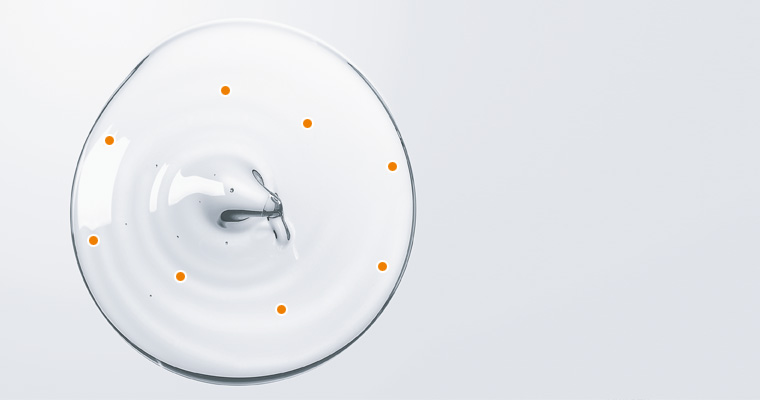The Group’s segment reporting is geared toward the internal organizational and reporting structure. WACKER reports on five operating segments (Siltronic, Silicones, Polymers, Polysilicon, and Fine Chemicals) which are organized and managed autonomously on the basis of the type of products they offer and their different risk and income structures. Any activities not assigned to an operating segment are shown under “Other.” Currency translation results which cannot be assigned to a segment are likewise shown in this item. Although the Fine Chemicals segment does not exceed the threshold values stipulated by IFRS 8, WACKER decided to report it as a segment subject to reporting requirements due to its specific product and customer structure.
Statement of financial position and statement of income items are assigned to the operating segments in accordance with commercial discretion. Assets used jointly by several segments are generally shown under “Other” if they cannot be assigned clearly to a particular segment. A similar approach is adopted for borrowed funds. For the geographical regions, the assets and liabilities are assigned in accordance with where the respective Group company’s site is located. Sales are classified in accordance with both the customer’s headquarters and the respective Group company’s site.
WACKER measures the segments’ success by the segmental success variables EBIT and EBITDA. EBIT consists of the gross result from sales, selling and general administrative expenses, research and development expenses, and other operating income and expenses less investments in joint ventures and associates and other income from investments. EBITDA is produced by adding depreciation and amortization, impairments, and write-ups to EBIT.
Asset additions, depreciation, amortization, and write-ups refer to intangible assets; property, plant, and equipment; investment property, and financial assets. Internal sales show the sales that are generated between the segments. They are settled mainly on the basis of market prices or planned direct costs. Segment information is essentially based on the same presentation and accounting methods as the consolidated financial statements. Receivables and liabilities, provisions, income, expenses, and results between the segments are eliminated in the course of consolidation.
The assets reported for the segments basically encompass all of their assets. Loans, cash and cash equivalents, and deferred tax assets, however, are generally allocated to the “Other” segment. The liabilities shown for the segments are basically comprised of all of their liabilities. The Group’s financial liabilities are allocated to individual segments in proportion to the segment assets. The Siltronic segment prepares its own partial consolidated financial statements. The figures in these financial statements are included largely unaltered in the Group’s segment information. For this reason, the apportionment rules (e.g. financial liabilities) applicable between the other segments do not apply to Siltronic.
Business with polyvinyl acetate solid resins for gumbase has been reposted in the Fine Chemicals division since the beginning of the second half of 2009. The gumbase business was reclassified from the Polymers segment as part of changes to internal management and reporting. Sales from gumbase business operations, which were reported in the Fine Chemicals segment for the first time, amounted to €19.7 million and resulted in a small positive contribution to earnings. In the previous year, sales amounted to €52.3 million and were generated in full by the Polymers segment. No adjustment was carried out for the previous year.
As of December 31, 2009, the assets of the Nünchritz production site were redistributed between the segments as some of these assets will additionally be serving production by another segment in the future. As a result, assets increased in “Other” – and decreased in Silicones – by €116.2 million. In addition, the further expenses of €47.9 million resulting from the adjustment of the mortality tables in the calculation of pension provisions and relating mainly to pensioners were allocated to the segment “Other.”
Of the impairments included with no effect on results, €12.8 million (previous year: €-37.9 million) is accounted for by the Siltronic segment and €– 1.8 million (previous year: €12.1 million) by “Other.” The impairments are essentially related to the changes in the market values of derivative financial instruments from cash flow hedging.
In addition to Germany, the USA and China are the only countries in which WACKER generates significant sales from a Group viewpoint. Measured in relation to the headquarters of the selling unit in the USA, sales amounted to €567.0 million (previous year: €710.1 million). Measured by the respective customer headquarters in the USA and China, the sales generated were €531.0 million (previous year: €748.5 million) and €509.5 million (previous year: €375.7 million) respectively. There are no customers with whom significant sales are generated.
The reconciliation of the segments’ aggregate results with the net result for the year is derived from the following list:
| download table |
|
€ million |
2009 |
2008 | ||
|
|
|
| ||
|
Reconciliation of segment results |
|
| ||
|
Operating result of reporting segments |
25.5 |
649.1 | ||
|
Consolidation |
1.3 |
-1.2 | ||
|
Group EBIT |
26.8 |
647.9 | ||
|
Financial result |
-23.5 |
-5.2 | ||
|
Limited partnership results |
– |
-0.9 | ||
|
Income before tax |
3.3 |
641.8 | ||
|
Income taxes |
-77.8 |
-203.5 | ||
|
Net result for the year |
-74.5 |
438.3 |








